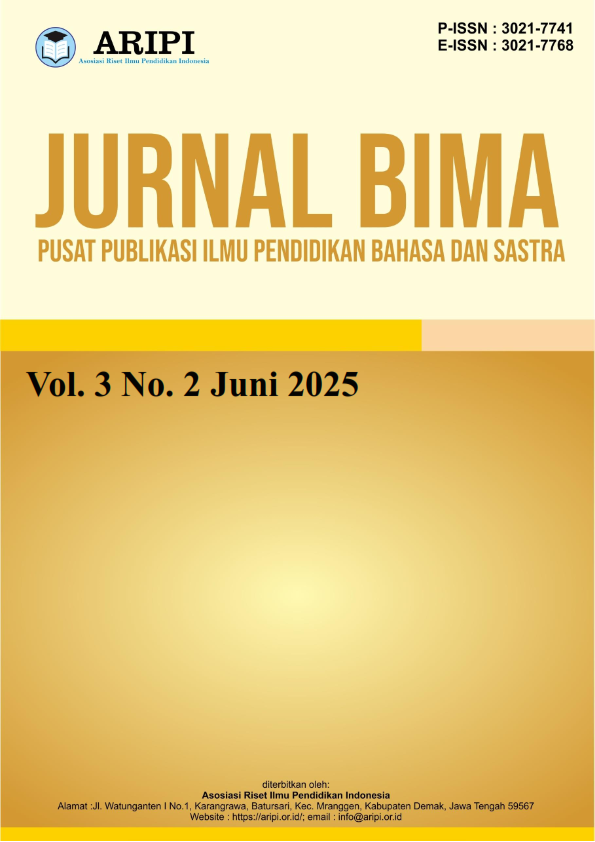Makna dalam Lirik Lagu “Paris Berantai” karya Anang Ardiansyah
DOI:
https://doi.org/10.61132/bima.v3i2.1757Keywords:
Paris barantai, hermeneutics, regional, songsAbstract
This article explores the significance found in the lyrics of the song "Paris Berantai" by Anang Ardiansyah through Paul Ricoeur's hermeneutic approach. This song is among the plethora of traditional Banjar music that not only provides enjoyable melodies but also incorporates social imagery that mirrors the values of Banjar society, including love, yearning, struggle, identity, and social dynamics. The methodology employed is qualitative descriptive with hermeneutic research methods, which involve a thorough interpretation of song lyrics as social works. This research seeks to uncover the implications within the lyrics that musically and artfully express the intricacies of local culture. The findings reveal that this song is not merely a traditional musical composition but also serves as a medium for conveying the character and intellect of Banjar society. This analysis indicates that each lyric of the song holds a philosophical significance that reflects the perspectives of the Banjar people on time, social relationships, nature, and the impact of external societies. Furthermore, this song portrays the experience of profound love and acts as a channel for conveying moral, spiritual, and social messages within a sophisticated context.
Downloads
References
Ardiansyah, A. (1978). Paris Berantai [Lagu Tradisional Banjar]. Banjarmasin: Dokumentasi Musik Kalimantan Selatan.
Barker, C. (2011). Cultural Studies: Teori & Praktik (T. Syswoyo, Trans.). Yogyakarta: Kreasi Wacana.
Endraswara, S. (2013). Metodologi Penelitian Sastra: Epistemologi, Model, Teori, dan Aplikasi. Yogyakarta: CAPS (Center for Academic Publishing Service).
Hanifah, N. (2023). Makna dalam Bahasa: Kajian Semiotika dan Semantik. Jakarta: Pustaka Bahasa Nusantara.
Hutomo, S. (1991). Nilai-nilai Budaya dalam Lagu Daerah Indonesia. Jakarta: Depdikbud.
Khalil, A. (2024). Pengantar Hermeneutika: Dari Schleiermacher hingga Paul Ricoeur. Yogyakarta: Pustaka Ilmu Filsafat.
Koentjaraningrat. (2009). Kebudayaan, Mentalitas dan Pembangunan. Jakarta: Gramedia Pustaka Utama.
Moleong, L. J. (2018). Metodologi Penelitian Kualitatif (Edisi Revisi). Bandung: Remaja Rosdakarya.
Palmer, R. E. (1969). Hermeneutics: Interpretation Theory in Schleiermacher, Dilthey, Heidegger, and Gadamer. Evanston: Northwestern University Press.
Ramadhani, R., Syamsuddin, A., & Lestari, D. (2024). Lagu sebagai Media Komunikasi Emosional: Sebuah Analisis Semiotika. Jurnal Seni dan Budaya Nusantara, 6(1), 45–57. https://doi.org/10.1234/jsbn.v6i1.678
Ricoeur, P. (1991). From Text to Action: Essays in Hermeneutics II (K. Blamey & J. B. Thompson, Trans.). Evanston: Northwestern University Press.
Santoso, I., Wulandari, T., & Hidayat, R. (2023). Eksistensi Musik Daerah sebagai Identitas Budaya Lokal. Jurnal Seni Musik Indonesia, 5(2), 88–102.
Sari, F. N., Maulana, R., & Wijaya, H. (2021). Lirik Lagu sebagai Bentuk Ekspresi Budaya dalam Masyarakat Urban. Jurnal Bahasa dan Sastra, 7(3), 150–165.
Sugiyono. (2020). Metode Penelitian Kualitatif, Kuantitatif dan R&D. Bandung: Alfabeta.
Susanti, L., Permana, H., & Putri, R. (2020). Fungsi Syair dalam Musik Populer dan Tradisional. Jurnal Linguistik dan Sastra, 4(2), 66–78.
Downloads
Published
How to Cite
Issue
Section
License
Copyright (c) 2025 Jurnal Bima : Pusat Publikasi Ilmu Pendidikan Bahasa dan Sastra

This work is licensed under a Creative Commons Attribution-ShareAlike 4.0 International License.






